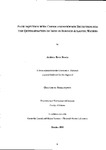FLOW INJECTION WITH CHEMILUMINESCENCE DETECTION FOR THE DETERMINATION OF IRON IN SURFACE ATLANTIC WATERS
| dc.contributor.author | BOWIE, ANDREW ROSS | |
| dc.contributor.other | Faculty of Science and Engineering | en_US |
| dc.date.accessioned | 2013-09-13T09:44:32Z | |
| dc.date.available | 2013-09-13T09:44:32Z | |
| dc.date.issued | 1999 | |
| dc.identifier | NOT AVAILABLE | en_US |
| dc.identifier.uri | http://hdl.handle.net/10026.1/1683 | |
| dc.description.abstract |
This thesis describes the design, optimisation and shipboard deployment of a flow injection - chemiluminescence (FI-CL) technique for the determination of iron (Fe) in seawater. Chapter One presents an overview of the marine biogeochemistry of Fe, including its speciation, sources and sinks, abundance and limitation for phytoplankton growth in the Wodd*s oceans. Current analytical methods for the determination of Fe in natural waters are also reviewed. Chapter Two reports the instrumental development of the FI - CL method. Each component is described and its suitability to the flow manifold discussed. Different CL detection systems are evaluated and a charge coupled device used to investigate the spectral profile of the Fe-catalysed luminol reaction. Automation of the FI manifold is also detailed along with acquisition of CL signals. Chapter Three details the optimisation of a FI - CL procedure for the determination of Fe in seawater. Reagent clean-up techniques, blank procedures and a standard addition operating routine are detailed. Fe(III) reduction using sulphite is treated theoretically. Matrix effects are investigated and the synthesis of an 8-hydroxyquinoline resin used for in-line matrix elimination and preconcentration is reported. The optimised method is selective to Fe(II+IIl) in the linear range 0.04-10 nM, with a precision of 3.2% (n=5) for a LO nM standard and a limit of detection (3s) of 40 pM for a load time of 1 min. Chapter Four presents the results of an investigation into the kinetic effect of Fe on luminol CL using the continuous addition of reagent (CAR) technique. Instrumental and chemical parameters are optimised, interferences investigated and the CAR-CL technique compared with alternative flow configurations. In Chapter Five, the application of the F - CL method to the shipboard determination of Fe in the surface North and South Atlantic (SO'^N to 50°S) is presented. Data are reported for samples collected from the upper water column (<200 m) in eight different biogeochemical provinces, which represent coastal, upwelling and oligotrophic regions of the Adbntic Ocean. Total dissolvable iron (unfiltered, TD-Fe) levels range ftom <0.1 to 6.1 nM and indicate that high and spatially variable TD-Fe (>2 nM) concentrations exist in Equatorial and tropical North Atlantic regions influenced by atmospheric deposition from the West African continent. Away from strong input mechanisms, TD-Fe concentrations in the upper water column average 0.6 nM. Input sources are fingerprinted via correlation with other trace metals (Al, Co, Ni), nutrients and hydrography, whilst active biological uptake is shown to be the dominant sink. TD-Fe vertical distributions through the upper mixed layer display strong relationships with chlorophyll a concentrations, and measurements in the deep chlorophyll maximum of the South Atlantic oligotrophic gyre show that, despite elevated nitrate at such depths, Fe concentrations are at a minimum (ca. 0.1 nM) and may be low enough to (co-)limit phytoplankton growth. | en_US |
| dc.description.sponsorship | Centre for Coastal and Marine Sciences - Plymouth Marine Laboratory | en_US |
| dc.language.iso | en | en_US |
| dc.publisher | University of Plymouth | en_US |
| dc.title | FLOW INJECTION WITH CHEMILUMINESCENCE DETECTION FOR THE DETERMINATION OF IRON IN SURFACE ATLANTIC WATERS | en_US |
| dc.type | Thesis | |
| plymouth.version | Full version | en_US |
| dc.identifier.doi | http://dx.doi.org/10.24382/3845 |
Files in this item
This item appears in the following Collection(s)
-
01 Research Theses Main Collection
Research Theses Main


